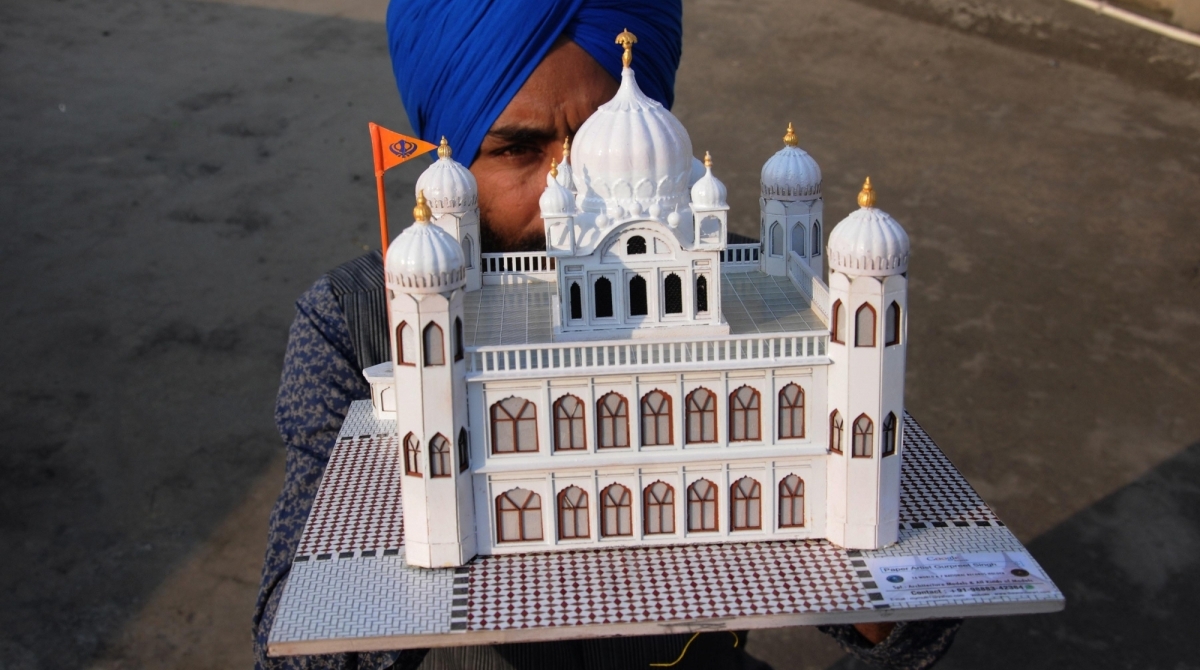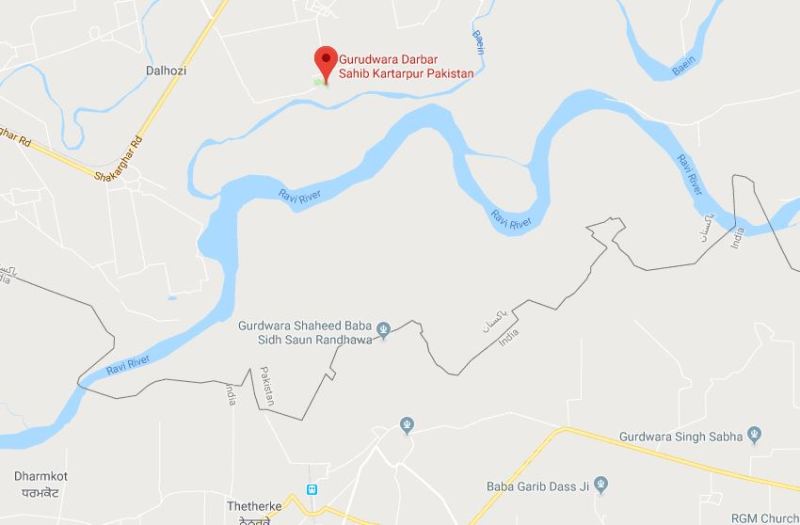Pakistan rejects US report on human rights practices
This year's report is once again conspicuous by its lack of objectivity and politicization of the international human rights agenda, it added.
On Thursday, just a day before the 549th birth anniversary of Guru Nanak, the Union Cabinet decided to build and develop a corridor from Dera Baba Nanak in Punjab’s Gurdaspur district to the international border for Sikh pilgrims to visit Pakistan’s Kartarpur Sahib gurdwara.

Paper artist Gurpreet Singh shows a model of Kartarpur Sahib, the final resting place of Guru Nank Dev, created by him, on the eve of the first Sikh Guru's birth anniversary, in Amritsar on Nov 22, 2018. (Photo: IANS)
Navjot Singh Sidhu was perhaps the happiest man on Thursday when the Centre cleared the decks for the Kartarpur Sahib Corridor upto the International Border with Pakistan in what marks as a major diplomatic move by New Delhi just a few months before the crucial 2019 Lok Sabha elections.
Following his visit to Pakistan in September this year, Sidhu, a Congress leader and minister in Punjab Chief Minister Amarinder Singh’s cabinet, had said that Islamabad was willing to open a corridor for pilgrims to access the Gurdwara Darbar Sahib (also called Kartarpur Sahib) located in Kartarpur on the banks of the river Ravi in Pakistan.
India’s decision
Advertisement
On Thursday, just a day before the 549th birth anniversary of Guru Nanak, the Union Cabinet decided to build and develop a corridor from Dera Baba Nanak in Punjab’s Gurdaspur district to the international border for Sikh pilgrims to visit Pakistan.
“The Kartarpur corridor will provide smooth and easy passage to pilgrims to visit Gurdwara Darbar Sahib throughout the year. Government of Pakistan will be urged to reciprocate and develop a corridor with suitable facilities in their territories,” Home Minister Rajjnath Singh tweeted following the decision which was taken in a meeting chaired by Prime Minister Narendra Modi.
In landmark decision, the Cabinet approves building and development of Kartarpur corridor from Dera Baba Nanak in Gurdaspur district to International Border. Kartarpur corridor project with all modern amenities and facilities to be implemented with Central Government funding.
— राजनाथ सिंह (@rajnathsingh) November 22, 2018
The Indian government will also approach Pakistan to reciprocate to the peace initiative.
In a tweet Sidhu, too, urged Pakistani Prime Minister Imran Khan to take steps to complete the corridor for the easy access for Indian Sikh pilgrims to the historic Gurdwara on the Pakistani side.
The Congress leader tweeted, “I thank the Govt. of India from the core of my heart and take a bow! I request the Hon’ble PM of Pakistan @ImranKhanPTI Sahib to take reciprocal steps for opening the Kartarpur Sahib corridor and spread Baba Nanak’s message of universal brotherhood and peace across the Globe.”
I thank the Govt. of India from the core of my heart and take a bow! I request the Hon’ble PM of Pakistan @ImranKhanPTI Sahib to take reciprocal steps for opening the Kartarpur Sahib corridor and spread Baba Nanak’s message of universal brotherhood and peace across the Globe.
— Navjot Singh Sidhu (@sherryontopp) November 22, 2018
Welcoming the Cabinet decision, Punjab Chief Minister Amarinder Singh thanked Prime Minister Narendra Modi for acceding to his request for celebrating the 550th birth anniversary of Guru Nanak – to be held in 2019 – in a grand manner.
Thank you PM @narendramodi ji for acceding to my request for celebrating the 550th Parkash Purab of Guru Nanak Dev ji in a grand manner & for approving the state government’s development programmes to make the celebrations memorable.
— Capt.Amarinder Singh (@capt_amarinder) November 22, 2018
Pakistan, too, welcomed India’s decision and announced that Prime Minister Imran Khan will lay the foundation stone for Kartarpur corridor on 28 November and it will be opened ahead of Guru Nanak’s 550th birth anniversary celebrations.
“It is a step in the right direction and we hope such steps will encourage voice of reason and tranquility on both sides of the border,” Pakistan Information and Broadcasting Minister Fawad Chaudhry tweeted.
“We welcome the Sikh community to Pakistan for this auspicious occasion,” the Minister added.
Indian Cabinet endorsement of Pakistan’s proposition on #KartarPurBorderOpening is victory of peace lobby in both countries, its a step towards right direction and we hope such steps ll encourage voice of reasons and tranquility on both sides of the border.
— Ch Fawad Hussain (@fawadchaudhry) November 22, 2018
Kartarpur Sahib’s history
Kartarpur was founded by Guru Nanak in 1515 AD. After completing four ‘Udaseean’ (journeys) in all four directions, Guru Nanak spent the last 18 years of his life in this town, which is today located in tehsil Shakargarh, Narowal District, Punjab, Pakistan. Guru Nanak appointed Guru Angad his successor in Kartarpur.
Following his demise, both the Hindu and Muslim followers of Guru Nanak argued over the last rites of the first Sikh Guru. While the Muslims wanted to bury his body, the Hindus wanted to cremate him. They decided to settle the matter by placing flowers over his body and agreed that whosoever’s flowers do not wither by morning shall have the right to the last rites. When the two groups returned the next day, they found the body missing but the flowers as fresh as they were a day before. The two groups thus decided to divide the flowers and carry out last rites according to their respective wishes. This is why Kartarpur Sahib has both a Samadhi and a grave of Guru Nanak.
The main shrine, as it stands today, was built on the Samadhi. The grave is outside on the courtyard.

Located around three kilometres inside Pakistan from the International Border, the foundation of the Kartarpur Sahib Gurdwara came up during the reign of Maharaja Ranjit Singh (1780-1839) on the site where Guru Nanak left for his heavenly abode in 1539.
According to Pakistani writer Haroon Khalid, author of Walking with Nanak, the Gurdwara fell to ruin as Sikhs in Pakistan left for India following partition. The site became a den of smugglers and drug addicts as there was not many around for the upkeep of the Gurdwara.
The site was somehow maintained by the Muslim followers of Guru Nanak, who continued to pray at the site.
Currently, Sikh jathas visit Kartarpur Sahib on four occasions every year – Guru Nanak’s birth anniversary, Baisakhi, Guru Arjan Dev’s martyrdom day and Maharaja Ranjit Singh’s death anniversary.
The political ropewalk
In 1995, the Pakistani government repaired the Gurdwara before fully restoring it in 2004.
When the then Prime Minister Atal Bihari Vajpayee visited Lahore in 1999, he raised the corridor matter and visa-free access for Sikh pilgrims with the Pakistani government. But Islamabad did not respond.
According to the Indian government, a 1974 protocol between India and Pakistan on visits to religious shrines does not include Kartarpur Sahib.

On 1 September 2004, the then Prime Minister Manmohan Singh announced the provision of corridor to Kartarpur Sahib on the eve of 400th anniversary of ‘Prakash Utsav’. His announcement came following a request from then Punjab Chief Minister Prakash Singh Badal.
Three days later, India requested that Kartarpur Sahib be included in the 1974 list during the Foreign Secretary level talks. Pakistan declined the request.
In 2005, Islamabad started granting visas to Sikhs to visit the Gurdwara along with two others but did not include it in the protocol.
India had again raised the Kartarpur Sahib Corridor matter in a 2008 meeting between then India’s External Affairs Minister Pranab Mukherjee and his Pakistani counterpart Shah Mehmood Qureshi. There had been no progress from the Pakistani side since then.
Interest in the corridor rose after Sidhu’s visit to Pakistan for the swearing-in ceremony of Pakistani Prime Minister Imran Khan.
Sidhu claimed that Pak Army chief General Qamar Javed Bajwa told him that Pakistani government will open the corridor to the Gurdwara.
But New Delhi said it had not received any official communication from Islamabad on the matter.
Union minister Harsimrat Kaur Badal had on 19 September reproduced a letter from Sushma Swaraj in which the External Affairs Minister said that the government has been taking up the matter of opening a passage to the Gurdwara but Islamabad “has so far neither agreed to include visits to Gurudwara Kartarpur Sahib by the Indian pilgrims…nor has it sent any official communication for establishing a corridor”.
Read More: Navjot Sidhu hits back at SAD, BJP day after Kartarpur Sahib controversy
“The External Affairs Minister will, therefore, raise this issue in her meeting with the Pakistani Foreign Minister on the sidelines of the UN General Assembly,” said EAM spokesperson Raveesh Kumar on 20 September.
Read More: Pakistan has not responded to our request to open Kartarpur Sahib
Corridor and security
The Gurdwara Kartarpur Sahib is located close to the Indian border. In fact, people on the Indian side can see the Gurdwara clearly on the Pakistani side when the tall elephant grass is trimmed. The corridor will be very close to Gurdaspur in Punjab, which was the site of a terror attack in 2015 by Pakistan-based terrorist group Lashkar-e-Taiba (LeT).
Thus the fears that the corridor may be used by Islamabad to create trouble in India and reignite the Khalistani sentiment exist. According to reports, Pakistan’s Inter-Services Intelligence (ISI) has been using several gurdwaras in the country for its pro-Khalistan campaign including the “Sikh Referendum 2020”.
Only a few days before the Cabinet announcement, a grenade attack on Nirankaris in Amritsar killed three and injured 19. Chief Minister Amarinder Singh accused the ISI of what he called a “clear case of terrorism”.
Another issue is Islamabad’s repeated denial of access to Indian pilgrims visiting gurdwaras in Pakistan. On Friday, 23 November, India protested the harassment of Consular officials of the High Commission of India in Islamabad by Pakistan and the denial of access to Gurudwara Nankana Sahib and Gurudwara Sacha Sauda on 21 November and 22 November despite Pakistani foreign ministry’s permission to meet Indian pilgrims.
The Ministry of External Affairs said in its statement that the Indian officials were therefore compelled to return to Islamabad without performing their diplomatic and consular duties with regard to the Indian pilgrims.
Read More: India protests ‘harassment’ of envoys, denial of consular access to Sikh pilgrims in Pak
The MEA said that Islamabad’s actions breached the letter and spirit of the 1974 Bilateral Protocol on visit to religious shrines and the Code of Conduct for the treatment of diplomatic/consular personnel in India and Pakistan, 1992.
India fears that Pakistan is using the visit of Indian pilgrims to incite communal disharmony and intolerance and promote secessionist tendencies with the objective of undermining India’s sovereignty and territorial integrity.
Advertisement